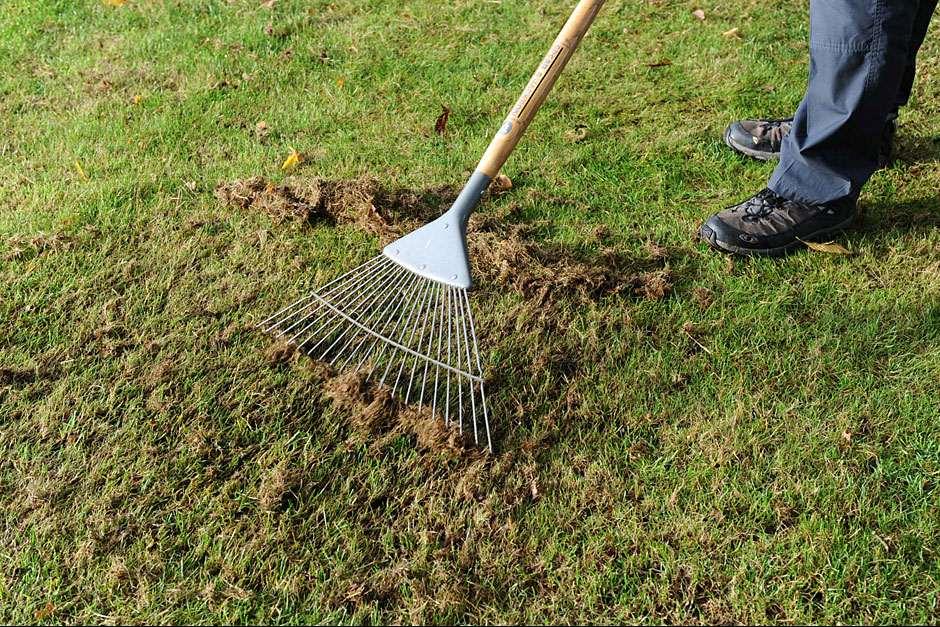Waterlogged lawns
If your lawn is regularly flooded after rain and the water only drains away slowly, this can damage your turf and encourage algae, moss and fungal problems. But there are several steps you can take to improve the situation, especially over winter.
Quick facts
- Waterlogging is usually caused by heavy and/or compacted soil
- It can cause fine turf grasses to die out, and moss and algae to flourish
- Late autumn and winter are the best times to take action
Causes of waterlogging
If your lawn is squelchy to walk on or turns into a lake every time it rains, you’ll have difficulty maintaining good quality, healthy turf. A sticky, glue-like layer of puddled soil may form near the surface, which is made worse by walking on the lawn, so try to keep off
There are a number of causes that can lead to waterlogging, including:
-
compacted soil, perhaps from heavy machinery (especially after building work) or simply from being walked on or played on regularly
-
heavy clay soil that naturally drains poorly
-
poor soil preparation before the lawn was created
If the problem is more widespread than just your lawn, see the following guide:
Waterlogging and flooding
Effects of waterlogging
Prolonged or repeated waterlogging can cause several issues:
-
Bare patches – finer grass species won’t grow well in waterlogged soil and may eventually die. Coarser, more robust species or weeds may then take over. See our guide to remedying patchy lawns:
Lawns: dead patchesLawns: dead patches
-
Algae, lichens and liverworts – these thrive in waterlogged conditions, affecting the appearance of the lawn, blocking light from reaching the grass and often making the surface slippery. Common examples include bubble-like nostoc algae and dog lichen, which both flourish in damp or poorly aerated soil. See our tips on controlling them:
Algae, lichens and liverworts on lawnsAlgae, lichens and liverworts on lawns
-
Moss – this will often colonise damp lawns, as well as shady areas and soil with a low pH (acidic). Although not usually welcome on high quality, fine lawns, moss can be an asset on less manicured lawns, greening up areas where grass fails to thrive and providing habitats for invertebrates. To learn more about the pros and cons of moss, and how to tackle it if you wish, see our guide:
Moss in lawnsMoss in lawns
-
Clumps of rushes – these may seed themselves into damp lawns, forming tussocks. See our tips on tackling lawn weeds:
Controlling weeds in lawnsControlling weeds in lawns
3 steps to improve your lawn
1 Aerate compacted soil
-
To improve drainage on compacted lawns, spike or aerate the soil so that rainwater can flow down into the ground more easily, rather than puddling on the surface. Wait until the standing water has drained away, or in small areas just sweep it off the lawn into the borders before aerating
-
You can use a garden fork to spike the lawn or a hollow-tined aeration tool, which removes plugs of soil. The holes should ideally be 10–15cm (4–6in) deep. For larger lawns, you can buy or hire a powered aerator. Sweep up and remove the soil plugs, then brush a free-draining ‘top dressing’, such as horticultural sand, into the holes
-
If your lawn is prone to waterlogging, spike it every few years in autumn. This will prevent the need for emergency action after wet winters
-
See our autumn lawn-care guide and video (aeration starts at 3:53 mins):
Autumn lawn care
Autumn lawn care
Lawn care in autumn
Lawn care in autumn
2 Look after your grass
-
Help your grass to recover from winter waterlogging and grow a more extensive and resilient root system by applying lawn feed in spring
-
Also feed in autumn with a lawn fertiliser that’s rich in phosphorus, which promotes root growth
-
Wet soil and dead patches allow moss to thrive in lawns over winter. Rake this out in spring to allow your grass to re-establish without competition. See our guide to tackling moss and repairing bare patches
3 Improve drainage in heavy soil
-
Heavy soil, rich in clay, tends to drain poorly, so your waterlogging problem may affect the whole garden. If so, consider installing a drainage system, as long as you have somewhere for the water to go (a ditch, drain or soakaway, for example)
-
Often there’s no easy way to shed excess water. In this case, it is sometimes worth replacing the lawn with a new one – strip off the old turf, dig over the area, incorporating plenty of organic matter to improve drainage, then rake and level. Cover with a 5cm (2in) layer of sharp sand, then either sow lawn seed or lay turf on top.
See also...
Bog gardens
Lawns: autumn care
Lawns: spring and summer care
Moss on lawns
Soil cultivation
Waterlogging and flooding
Get involved
The Royal Horticultural Society is the UK’s leading gardening charity. We aim to enrich everyone’s life through plants, and make the UK a greener and more beautiful place.